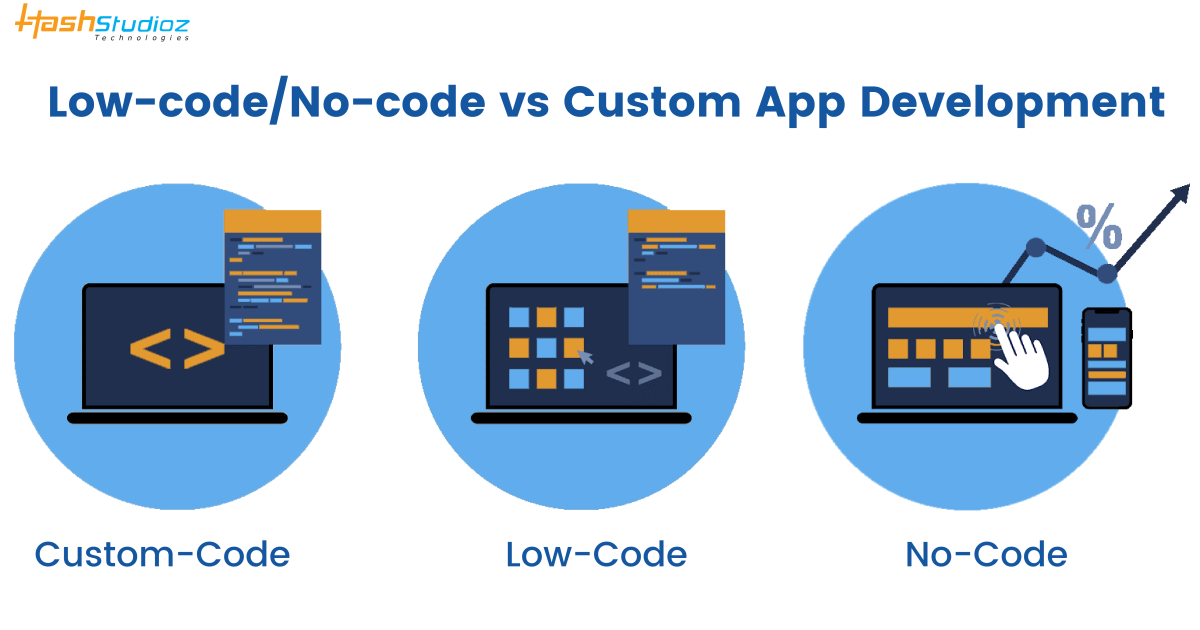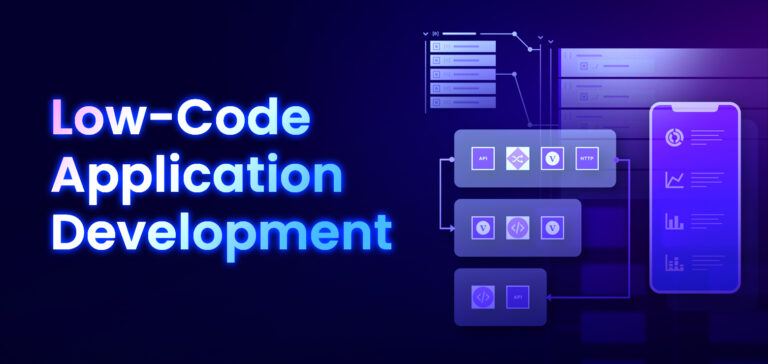Good News To Selecting application development with Low-code platforms
Wiki Article
App Development Using Low-Code Is More Efficient.
Visual Development Environment :
Drag-and-Drop Interfaces: Low-code platforms provide visual tools for designing applications. Drag-and-drop components are a great tool for developers to quickly assemble apps without coding.
Templates and pre-built components A lot of low-code platforms include pre-built components and templates that allow developers to rapidly prototype and create applications.
Coding requirements that are less invasive:
Automated Generated Code: Lowcode platforms create the code base on the visual models created developers. It reduces the need to code manually and accelerates development.
Reusable Components : Developers can reuse components in various projects to cut down on the time spent writing and testing codes.
Collaboration can be streamlined.
Low-code development platforms are typically equipped with tools such as deployment control, version control and testing. This enables seamless collaboration between teams.
Citizen Development: Users of businesses and non-developers can contribute to the development of applications using simple interfaces, reducing the bottleneck that is often caused by the limited accessibility of professionals.
Rapid prototyping, rapid iteration and rapid prototyping
Fast prototyping: Developers can create prototypes quickly to validate ideas and collect feedback. This can result in a faster iteration cycles.
Simple Modifications. Low-code development's visual nature makes it easy for users to modify and update their apps.
Pre-built Integrations:
API Integrations: Low-code platforms often have pre-built connectors for APIs and services that are popular making it easier to integrate external systems.
Data Integration: Built in tools for data integration make it easier to connect databases and other data sources. This speeds up development.
Deployment and Scaling
Many low-code platforms provide one-click options for deployment that reduces the time and effort required to deploy applications.
Cloud-based Solutions: Cloud platforms with low-code allow developers to concentrate on the logic and functionality of their apps instead of worrying about logistics for deployment.
Overall, the advantage of developing applications using low-code in terms of speed lies in the ability of it to streamline and automate various aspects of the development process, enabling rapid delivery of apps and quicker adaptation to changing requirements. Check out the best extra resources for Low-code Platform for application development for blog advice including develop mobile application, rapid action development, rapid action development, software for app development, application development platforms, application modernisation, microsoft azure sql, software for app development, lowcode no code, app dev platform and more.

Benefits Of Developing Applications Using Low-Code With Respect To Governance And Security
Low-code application design offers many advantages when it comes to governance and security. Both are vital to making sure that applications remain safe, compliant and well-managed throughout their entire life cycle. These are the benefits of developing low-code applications:
Unified management console: Low-code platforms typically have a central administration console from which administrators can manage all applications and maintain a consistent governance within the company.
Role-Based Access Control RBAC (RBAC). These platforms typically provide robust access control by role, which gives administrators to establish and enforce their own access policies. Only authorized users are able to modify or access certain elements of a program.
Compliance and Regulatory Adherence
Many low-code platforms come with integrated compliance features. For instance, they are developed in accordance with industry standards, regulations and laws (e.g. HIPAA, GDPR). They offer frameworks and tools to ensure that applications comply with standards.
Audit Trails & Logging: Audit trails and logs that are comprehensive can be integrated to allow organizations to track change in access, and monitor access and compliance.
Increased Security Measures
Data Encryption: Low-code systems generally provide encryption built-in for data in transit and during transit, which ensures that data with sensitive information is secure.
Security Certificates: A lot of low code providers have security certificates (e.g. ISO 27001 and SOC 2) which demonstrate that they are adhering to strict security guidelines. They also provide an extra degree of security to clients.
Automated updates to ensure security:
Regular Patching and Updates: Low-code platforms typically handle regular patches and security updates automatically, making sure that applications are protected against the most recent threats, without the need for the intervention of developers.
Security Monitoring: Tools for continuous security monitoring are included. They provide real-time alerts, as well as insight into security issues that might arise.
Data Governance:
Data Access Policies These systems enable organizations to define data access policies and enforce these policies to ensure that data is available only to users who are authorized. They also ensure the data is used correctly.
Data Masking, Anonymization, and Anonymization Tools: These tools assist to safeguard sensitive personal data and are particularly helpful for testing environments.
Continuous application lifecycle management
Development and deployment pipelines: Lowcode platforms typically provide integrated pipelines for deployment and development that incorporate security tests. They ensure security throughout the application's lifecycle.
Version Control: An integrated version control system can help control changes, allowing any modifications that are made to an application to be monitored. If needed they can be reversed and the integrity of the application ensured.
User Authentication Authorization
Single Sign-On (SSO) Support for single sign-on as well as other advanced authentication mechanisms simplify management of users and improves security.
Multi-Factor Authentication Most platforms have built-in support of multi-factor authentication. This adds an extra layer of security for applications.
Policy enforcement and Compliance monitoring:
Policy Templates: Low code platforms typically have templates for governance and security that allow organizations to quickly implement policies.
Compliance Monitoring Tools: They provide continuous monitoring and report on the status of compliance. This makes it easier to identify potential issues and address them proactively.
Integration into Existing Security Infrastructure
Seamless Integration: Low-code platforms are designed to work seamlessly with the existing security infrastructure and tools, such as identity management tools and SIEMs (Security Information and Event Management Solutions), and firewalls.
API Security API Security features make it possible to integrate with external systems, safeguarding information and ensuring integrity of the applications.
Training and best practices:
Guided Best Practices : Many platforms provide guidelines and best practices to assist non-developers to adhere to security standards.
Security Training: A few low-code vendors provide security training and resources that help users understand how to create and maintain secure applications.
Overall the security and governance advantages of developing applications using low-code ensure that applications are built and operated in a secure as well as compliant manner. These platforms contain the tools and frameworks needed to supervise and control process of developing applications, and secure sensitive data, while ensuring regulatory compliance and enforcing policies. Follow the most popular additional resources for Legacy application modernization with Low-code for site examples including no code platforms, cloud software applications, cross platform app development, rapid application design, microsoft azure sql, microsoft azure sql, application modernization software, azure sql, mobile development platforms, push alerts and more.

The Benefits Of Low-Code Programming For Application Development In Terms Of Restrictions And The Possibility Of Customization
Low-code applications offer a balanced approach that provides important advantages in terms of dealing with limitations and permitting modification. Here are some of the main benefits:Handling limitations:
Resolving Complexity:
Simple development: Platforms that use low-code reduce the amount of work by supplying templates and components that are pre-built, enabling rapid development and deployment for complicated applications.
Numerous platforms offer wizards and workflows that are guided to aid developers in understanding complicated processes. These tools reduce the chance of making mistakes, and also help to ensure the consistency of.
Scalability Solutions
Scalability Built-In Lowcode platforms usually have capabilities to enable an scalable architecture. They enable applications to cope with increasing demands without major redevelopment.
Performance Monitoring Tools: Instruments for monitoring and enhancing performance are incorporated into the application to ensure it remains efficient regardless of how it expands.
Security and compliance
Low-code platforms have built-in security options, such as security access control that is based on roles encryption, as well as automated checks for security compliance. These features address commonly-asked security issues.
Platforms are continuously updating their security protocols and measures of compliance, which ensures that the applications are secure against new threats.
Customization:
Extensibility:
Low-code platforms permit developers to extend functionality beyond standard offerings by using customized code.
Modifications and plugins that are custom: Developers can create custom plugins or modules to include specific functions that are tailored to specific business needs.
APIs and Integration
API Support: Full API support allows seamless integration of other systems and services. This allows for large customization and connection.
Third Party Services: Low-code platforms often offer pre-built connectors for well-known third-party services, making it easier to integrate and customize applications.
Designing UI/UX that is flexible:
User-friendly interfaces with customizable options: Users can create and customize their own user interfaces that will give a more tailored experience.
Responsive Web Design The built-in design responsive features allow applications to be customized depending on the screen size and device.
Business Logic Customization:
Visual Workflow Builders Visual tools for designing and customizing workflows as well as business logic allow developers to build complex, custom-designed workflows without code.
Conditional Logic and scripting : Platforms allow conditional logic and custom scripting in order to meet specific business rules.
Data Management:
Custom Data Models Developers have the ability to build custom data models specifically tailored to the specific needs of a business. This will ensure that data handling is tailored for every application.
Advanced Data Processing: Integration of advanced tools and capabilities to process data allows customizations in the way data is processed in an application.
Balancing Customization with Limitations
Frameworks & Standards
Low-code platforms are compliant with the industry standard and best practice. This allows for the highest quality and security of applications.
Governance Frameworks. Inbuilt governance frameworks can help ensure that any modifications are not detrimental to the security, integrity or security of the application.
Iterative Development and Feedback:
Rapid Prototyping. Developers can iterate and modify applications based on the feedback of users.
Low-code platforms enable continuous improvement by allowing the continuous improvement of their design and enhancements the platform as requirements of business evolve.
Empowering Users:
Giving Citizen Developers the tools they need: Low-code platforms boost the number of contributors capable of enhancing and modifying applications through permitting them to create custom intuitive user interfaces.
Training and support: Many platforms include extensive training resources as well as support services to help users in making modifications that are effective without compromising the application's performance or stability.
Low-code applications provide a flexible framework which can be customized to meet the specific requirements. This allows companies to create and maintain functional apps designed to meet their requirements while ensuring high standards of quality, security, and scaling.
